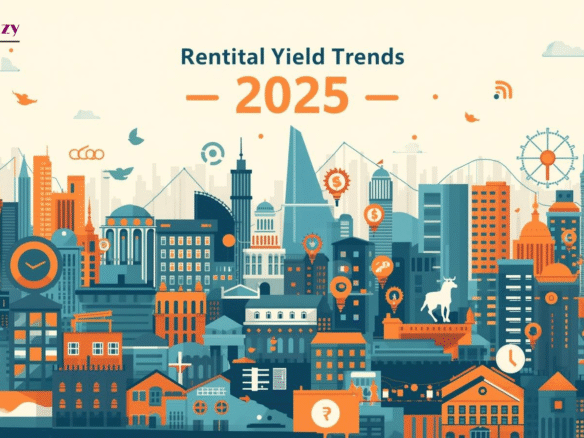The Yamuna Expressway is not just a stretch of modern infrastructure; it is a symbol of India’s vision for the future. Stretching across 165 kilometers, this six-lane expressway connects Greater Noida with Agra and has rapidly evolved into more than just a high-speed corridor. It has become a lifeline for commerce, real estate, tourism, and industrial growth. Today, the Yamuna Expressway stands as a true “Gateway to Tomorrow,” ushering in new opportunities for development, connectivity, and investment.
A Vision Realized in Concrete and Asphalt
When the Yamuna Expressway was inaugurated in 2012, the goal was clear: reduce travel time between Delhi NCR and Agra, while providing a world-class road infrastructure. With a designed speed limit of 100 km/h, it brought down travel time from nearly 4 hours to less than 2. But beyond convenience, the expressway has created a ripple effect that continues to shape the socio-economic landscape of Uttar Pradesh and the surrounding regions.
From the start, it wasn’t just about moving vehicles faster. The planners envisioned it as a catalyst for industrial corridors, residential hubs, and commercial zones that would transform the region into a magnet for investment. More than a decade later, that vision is becoming reality.
Strategic Importance
The Yamuna Expressway’s location is its greatest strength. Situated in proximity to Delhi, Noida, and Greater Noida, the region sits at the heart of North India’s economic ecosystem. Its alignment with the Yamuna River gives it a natural advantage in terms of geography, while its connectivity ensures that industries and communities are seamlessly integrated with the rest of the country.
This corridor is also strategically linked to key infrastructure projects:
- Jewar Airport (Noida International Airport): Set to be one of the largest airports in Asia, this airport near the expressway will unlock massive opportunities in aviation, logistics, tourism, and hospitality.
- Dedicated Freight Corridors: The expressway aligns with India’s larger goal of building efficient freight movement systems, boosting industrial clusters.
- Proximity to Delhi-Mumbai Expressway and Eastern Peripheral Expressway: Together, these road networks form a web of connectivity that will redefine trade and travel in northern India.
Real Estate Boom Along the Expressway
The most visible impact of the Yamuna Expressway has been in the real estate sector. What was once considered a remote stretch of land has now become a hotspot for residential townships, commercial complexes, and industrial parks. Developers have seized the opportunity, creating integrated townships with modern amenities, affordable housing projects, and luxury villas that cater to diverse segments of buyers.
The upcoming Jewar Airport has further fueled this boom, as investors see the potential for exponential growth in land value. Commercial hubs, data centers, and warehousing facilities are also mushrooming, making the region a lucrative option for both long-term investors and businesses seeking strategic locations.
Industrial and Economic Growth
The Yamuna Expressway Industrial Development Authority (YEIDA) has been instrumental in shaping the industrial ecosystem along the expressway. Industrial plots have been allotted to companies in sectors such as IT, manufacturing, electronics, textiles, and food processing. Special Economic Zones (SEZs) and logistics parks are being developed, aligning with the government’s “Make in India” initiative.
The expressway is also attracting global attention. With the international airport and world-class connectivity, multinational corporations and startups alike see it as fertile ground for innovation and expansion. The region is expected to generate thousands of jobs in the coming decade, making it a hub of employment and skill development.
Tourism: Redefining Travel Experiences
One of the original goals of the Yamuna Expressway was to boost tourism, particularly by enhancing access to Agra—the city of the Taj Mahal. Today, it has achieved that and much more. Weekend tourism has surged, with travelers from Delhi NCR flocking to Agra, Mathura, and Vrindavan thanks to the smoother and faster travel experience.
The expressway itself is dotted with rest areas, food courts, and entertainment zones, making the journey as enjoyable as the destination. Upcoming tourism projects near Jewar Airport, including theme parks and hospitality chains, are set to further amplify this sector’s growth.
Smart City Development
The vision for the Yamuna Expressway region extends beyond roads and real estate—it is about creating smart, sustainable cities. YEIDA has already initiated projects that focus on eco-friendly development, renewable energy integration, and digital infrastructure. Concepts like integrated townships, green belts, and solar power plants are being incorporated to ensure balanced growth.
This aligns with India’s broader goal of sustainable urbanization, where growth is not just measured in economic terms but also in environmental and social responsibility.
Challenges Along the Road
Despite its many achievements, the Yamuna Expressway journey hasn’t been without challenges. Land acquisition disputes, safety concerns due to high-speed driving, and the need for better last-mile connectivity are some issues that require attention. Additionally, ensuring sustainable development without overburdening natural resources is a constant balancing act.
However, continuous policy support from the Uttar Pradesh government and the central government is helping address these issues. The introduction of strict safety norms, increased patrolling, and planned expansion of service roads are some measures being implemented.
The Future Ahead
The Yamuna Expressway is not just about today—it is about the next 20 to 30 years. With Jewar Airport set to operationalize in phases from 2025, the region is poised to transform into an international hub for business and lifestyle. Predictions indicate that the Yamuna Expressway belt could rival Gurgaon and Noida as the next powerhouse of real estate and commerce.
Upcoming developments include:
- Expansion into an 8-lane expressway to accommodate future traffic.
- High-speed metro and rapid rail connectivity to Greater Noida and Delhi.
- IT parks, film cities, and educational institutions boosting the knowledge economy.
- Greenfield projects promoting smart living with sustainability at their core.
Why It Truly Is the Gateway to Tomorrow
The Yamuna Expressway embodies the idea that infrastructure is the foundation of progress. It is not just a road; it is a catalyst for opportunities—economic, cultural, and social. From connecting two iconic cities (Delhi and Agra) to anchoring India’s largest upcoming airport, from attracting global investments to creating sustainable urban hubs, the expressway is laying down the blueprint for future-ready development.
As industries grow, cities expand, and millions find new livelihoods along its length, the Yamuna Expressway is living proof of what visionary planning and execution can achieve. For India, it is more than a concrete road—it is a symbol of aspiration, transformation, and limitless possibilities.






Join The Discussion